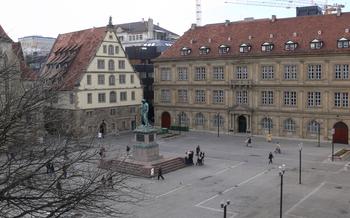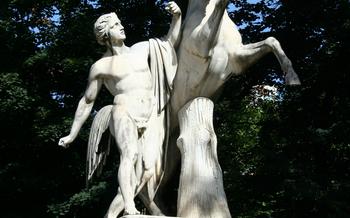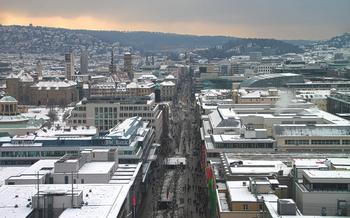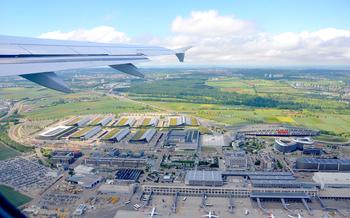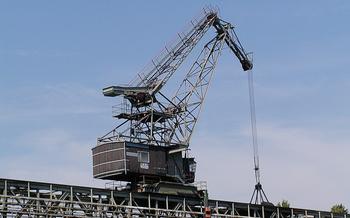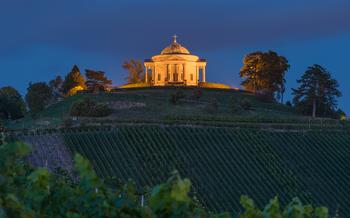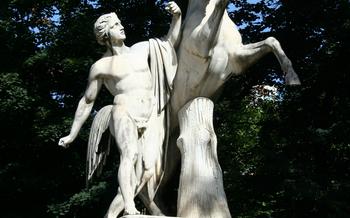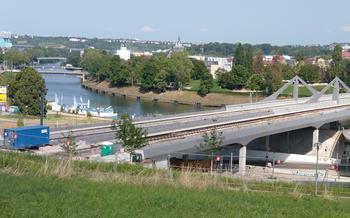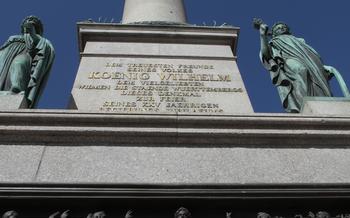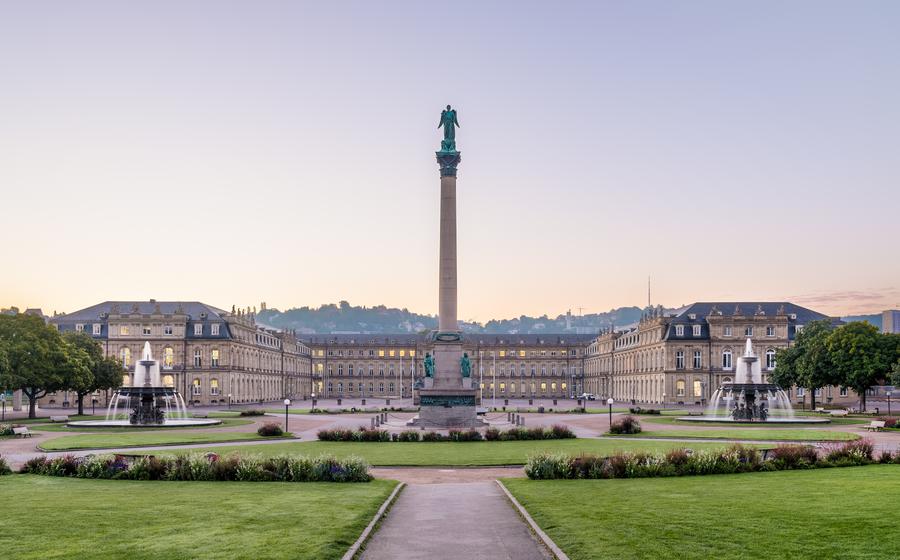
Schlossplatz
- Schlossplatz: A Historical City Center
- Neues Schloss: A Royal Residence
- Altes Schloss: A Medieval Fortress
- Königsbau: A Neoclassical Masterpiece
- Staatstheater Stuttgart: A Cultural Hub
- Kunstgebäude Stuttgart: A Treasure Trove of Art
- Grabkapelle auf dem Württemberg: A Royal Mausoleum
- Wilhelma Zoo and Botanical Garden: A Natural Oasis
- Mercedes-Benz Museum: A Tribute to Automotive History
- Porsche Museum: A Celebration of Sports Cars
- Stuttgart Hauptbahnhof: A Transportation Hub
- Shopping in Stuttgart: A Retail Paradise
- Dining in Stuttgart: A Culinary Journey
- Nightlife in Stuttgart: A Vibrant Scene
- Insider Tip: Hidden Gems of Stuttgart
Schlossplatz: A Historical City Center
The Schlossplatz, or Palace Square, is the heart of Stuttgart, Germany. A historic square with a rich past, it has been a witness to many significant events and transformations throughout the city's history.
The square's origins date back to the 13th century when it was used as a marketplace and a gathering place for the townspeople. In the 16th century, Duke Christoph of Württemberg ordered the construction of the Neues Schloss, or New Palace, which became the residence of the württemberg rulers. With the palace as its centerpiece, the Schlossplatz transformed into a grand and elegant square, surrounded by magnificent buildings and landmarks.
Over the centuries, the Schlossplatz has undergone several architectural changes, reflecting the evolving tastes and styles of different eras. Today, the square is a harmonious blend of architectural styles, from the Renaissance and Baroque to Neoclassical and Modern.
The Schlossplatz is not just a historical landmark but also a vibrant public space. It hosts a variety of events and festivals throughout the year, including concerts, markets, and cultural exhibitions. During the Christmas season, the square comes alive with a festive atmosphere, with a large Christmas tree, twinkling lights, and bustling Christmas markets.
Neues Schloss: A Royal Residence
The Neues Schloss, or New Palace, is a magnificent baroque palace located in the heart of Stuttgart. Construction began in 1746 under the reign of Duke Carl Eugen and was completed in 180The palace was designed by renowned architects Leopoldo Retti and Johann Friedrich Weyhing and served as the official residence of the württemberg rulers until 191
The Neues Schloss boasts an impressive facade adorned with intricate carvings, sculptures, and gilded ornaments. The interior of the palace is equally opulent, featuring grand halls, stately rooms, and a magnificent ballroom. Visitors can admire the exquisite artwork, tapestries, and furniture that adorn the palace's many chambers, providing a glimpse into the lavish lifestyle of the former württemberg monarchs.
Today, the Neues Schloss is used for various purposes, including government offices, state receptions, and cultural events. Guided tours are available for visitors who wish to explore the palace's rich history and admire its architectural splendor. The palace is a symbol of Stuttgart's royal heritage and a must-visit attraction for anyone interested in history, architecture, or culture.
Altes Schloss: A Medieval Fortress
The Altes Schloss, or Old Castle, stands as a testament to Stuttgart's rich history and architectural heritage. Once a formidable fortress guarding the city, this imposing structure has undergone numerous transformations over the centuries, reflecting the changing tides of time.
In the 13th century, the foundation of the Altes Schloss was laid by Count Ulrich I of Württemberg. Initially designed as a defensive stronghold, the castle comprised a series of imposing walls, towers, and moats. As the city of Stuttgart grew in prominence, the castle served as the residence of the Württemberg counts and dukes, who expanded and embellished it over the years.
The architectural style of the Altes Schloss is a fascinating blend of medieval and Renaissance influences. The sturdy walls and towers evoke a sense of strength and resilience, while the ornate facades and intricate carvings hint at the opulence and grandeur that once graced the castle's interior. Highlights include the impressive Renaissance-style courtyard, the grand staircase leading to the upper floors, and the preserved medieval chapel, which offers a glimpse into the religious life of the castle's former inhabitants.
Today, the Altes Schloss serves as a vibrant cultural and historical center. It houses the Landesmuseum Württemberg, one of the oldest and most comprehensive museums in Germany. The museum's vast collection spans prehistoric artifacts, medieval treasures, and modern art, providing visitors with a captivating journey through the cultural and artistic heritage of the region.
Guided tours of the Altes Schloss are available, offering visitors an immersive experience and a chance to delve deeper into its fascinating history and architectural details. The castle's unique blend of medieval charm and Renaissance elegance, combined with the captivating exhibits of the Landesmuseum Württemberg, make it an essential destination for anyone seeking to explore the rich tapestry of Stuttgart's past.
Königsbau: A Neoclassical Masterpiece
Amidst the historical grandeur of Stuttgart's Schlossplatz, the Königsbau stands as a testament to the city's architectural prowess. Erected between 1846 and 1850, this Neoclassical masterpiece was designed by renowned architect Ludwig von Zanth and epitomizes the architectural style that dominated Europe in the 19th century.
Distinguished by its symmetrical façade, the Königsbau features a grand portico supported by imposing Ionic columns. The building's exterior is adorned with intricate carvings and sculptures, each narrating a tale from Greek mythology. The tympanum, positioned above the portico, showcases a dramatic scene depicting the Battle of the Centaurs and Lapiths, adding to the building's captivating allure.
Originally conceived as a residential palace for King Wilhelm I of Württemberg, the Königsbau underwent a transformation in 1918 when it was converted into the seat of the Württemberg State Parliament. Today, it serves as a prominent government building, housing the offices of the state's legislative body.
Guided tours of the Königsbau are available, providing visitors with an opportunity to delve into its rich history and admire its architectural splendor. Visitors can marvel at the grand staircase, adorned with intricate wrought-iron railings, and explore the opulent halls, each adorned with opulent chandeliers, ornate plasterwork, and polished marble floors.
Whether admired from afar or explored up close, the Königsbau stands as a testament to Stuttgart's architectural heritage and offers a glimpse into the city's regal past.
Staatstheater Stuttgart: A Cultural Hub
A cornerstone of Stuttgart's cultural scene, the Staatstheater Stuttgart is a grand theater complex that has captivated audiences for over a century. Its origins can be traced back to 1807 when it was established as the Königliches Hoftheater. Over the years, the theater has undergone several renovations and expansions, resulting in a magnificent complex that houses three distinct venues: the Großes Haus, the Kleines Haus, and the Schauspielhaus.
The Großes Haus, the main auditorium of the Staatstheater, boasts an opulent neoclassical interior with intricate ceiling frescoes, plush red velvet seats, and a grand stage that has hosted countless world-renowned performances. With a seating capacity of over 1,200, this venue is perfect for grand operas, ballets, and symphony concerts.
The Kleines Haus, a smaller and more intimate venue, offers a more contemporary setting for experimental productions, chamber concerts, and recitals. Its flexible stage configuration and state-of-the-art acoustics make it an ideal space for innovative and thought-provoking performances.
The Schauspielhaus, the theater's third venue, is dedicated to spoken drama and contemporary theater productions. With its thrust stage and versatile seating arrangements, this venue fosters a close connection between performers and audiences, creating an immersive and engaging theatrical experience.
Throughout the year, the Staatstheater Stuttgart presents a diverse program of over 400 performances, including opera, ballet, drama, and concerts. The theater is home to a talented ensemble of actors, singers, dancers, and musicians, who bring to life a wide range of productions, from classic masterpieces to contemporary premieres.
Kunstgebäude Stuttgart: A Treasure Trove of Art
The Kunstgebäude Stuttgart is a magnificent art museum located in the heart of the Schlossplatz. It was constructed in 1904 and designed by renowned architect Paul Bonatz in the Neoclassical style. The building's striking façade features intricate carvings, sculptures, and a grand entrance that invites visitors to explore the treasures within.
Inside the Kunstgebäude, visitors are greeted by a vast collection of artworks spanning various eras and genres. The museum's permanent exhibition includes masterpieces from the Middle Ages to the present day, including paintings, sculptures, drawings, and prints. Highlights include works by Albrecht Dürer, Lucas Cranach the Elder, Max Liebermann, and Otto Dix.
The Kunstgebäude also hosts temporary exhibitions featuring both established and emerging artists. These exhibitions often explore specific themes, movements, or periods in art history, providing visitors with a deeper understanding of the artistic landscape.
Guided tours are available for those who wish to delve deeper into the museum's collection. Knowledgeable docents lead visitors through the galleries, sharing insights into the artworks and their historical context. The museum is wheelchair accessible and offers a variety of educational programs and workshops for visitors of all ages.
Whether you are an art enthusiast or simply looking to appreciate the beauty of historic architecture, the Kunstgebäude Stuttgart is a must-visit destination. Prepare to be captivated by the diverse and stunning collection of artworks that await you within its walls.
Grabkapelle auf dem Württemberg: A Royal Mausoleum
The Grabkapelle auf dem Württemberg is a captivating mausoleum perched atop the Württemberg hill, overlooking the city of Stuttgart. This grand neoclassical structure was built as the final resting place for King Wilhelm I and Queen Katharina of Württemberg. Completed in 1824, the mausoleum exudes an aura of serenity and grandeur.
The architectural features of the Grabkapelle are both striking and symbolic. The building's rotunda is crowned by a majestic dome, supported by towering Ionic columns. The exterior is adorned with intricate carvings and sculptures, depicting scenes from classical mythology and the life of Christ. The interior is equally impressive, with its ornate marble floors, elaborate frescoes, and a stunning stained-glass window that filters light into the serene space.
The significance of the Grabkapelle goes beyond its architectural beauty. It stands as a testament to the enduring legacy of the Württemberg monarchy and their deep connection to the city of Stuttgart. The mausoleum has become a beloved landmark, visited by both locals and tourists alike, who come to pay their respects and admire its artistic and historical significance.
Guided tours of the Grabkapelle are available, providing visitors with a deeper insight into its history, symbolism, and architectural details. The mausoleum is open to the public during specific hours, offering an opportunity for visitors to explore this tranquil oasis and reflect on the lives of the Württemberg royals laid to rest within its hallowed walls.
Wilhelma Zoo and Botanical Garden: A Natural Oasis
In the heart of Stuttgart, nestled amidst lush greenery, lies the Wilhelma Zoo and Botanical Garden, an enchanting haven for nature enthusiasts. Founded in 1846 by King William I, this remarkable institution combines the charm of a zoo with the tranquility of a botanical garden, offering a unique and immersive experience.
The Wilhelma Zoo is home to over 11,000 animals representing more than 1,200 species from around the world. From majestic lions and playful meerkats to exotic birds and fascinating reptiles, the zoo provides a glimpse into the diverse wonders of the animal kingdom. Visitors can embark on a journey through various habitats, including the African savanna, the Asian rainforest, and the Polar regions, encountering creatures from every corner of the globe.
Complementing the zoo is the enchanting Botanical Garden, a verdant paradise that showcases over 8,500 plant species from across the globe. Visitors can wander through meticulously landscaped gardens, admiring vibrant flowerbeds, towering trees, and exotic plants. The greenhouses, with their controlled climates, offer a glimpse into the botanical treasures of different ecosystems, from tropical rainforests to arid deserts.
Beyond its role as a zoo and botanical garden, the Wilhelma is also a renowned center for conservation and education. The institution actively participates in various conservation programs, contributing to the preservation of endangered species and promoting sustainable practices. Educational initiatives and guided tours provide visitors with insights into the natural world, fostering a deeper appreciation for the delicate balance of our planet's ecosystems.
Whether you seek a day of adventure and discovery or a peaceful retreat surrounded by nature, the Wilhelma Zoo and Botanical Garden is a must-visit destination in Stuttgart. Prepare to be captivated by the wonders of the animal kingdom and the beauty of the plant world, all within the embrace of this enchanting urban oasis.
Mercedes-Benz Museum: A Tribute to Automotive History
The Mercedes-Benz Museum is a captivating tribute to the rich history and innovative spirit of one of the world's most renowned automotive brands. Located in Stuttgart, Germany, the museum takes visitors on a journey through the evolution of Mercedes-Benz, showcasing iconic vehicles, interactive exhibits, and cutting-edge technology.
The museum's collection is a treasure trove for car enthusiasts, featuring over 160 vehicles that span the entire history of the brand. From the earliest models like the 1886 Benz Patent-Motorwagen, widely regarded as the world's first automobile, to the sleek and futuristic concept cars, the museum offers a comprehensive overview of Mercedes-Benz's automotive legacy.
Beyond the cars, the Mercedes-Benz Museum also delves into the company's contributions to motorsport, engineering, and design. Interactive exhibits allow visitors to experience the thrill of racing simulators, explore the intricate details of engine components, and witness the creative process behind Mercedes-Benz's iconic designs.
A highlight of the museum is the "Collection Room," which showcases a rotating selection of rare and historically significant Mercedes-Benz vehicles. From the legendary 300 SL "Gullwing" to the ultra-luxurious Maybach limousines, these cars represent the pinnacle of automotive excellence and craftsmanship.
The Mercedes-Benz Museum is not just a museum; it's an immersive experience that celebrates the passion, innovation, and engineering prowess that have shaped the automotive industry. Whether you're a car enthusiast, a history buff, or simply someone who appreciates cutting-edge technology, the Mercedes-Benz Museum is a must-visit destination in Stuttgart.
Porsche Museum: A Celebration of Sports Cars
History of the Museum: The Porsche Museum, a tribute to the legendary German sports car manufacturer, opened its doors in 200Located in the heart of Stuttgart-Zuffenhausen, the museum showcases the rich history, innovation, and passion that have shaped the Porsche brand.
Interactive Exhibits and Displays: Step into the world of Porsche and immerse yourself in interactive exhibits that bring the brand's story to life. Explore the evolution of Porsche's iconic sports cars through multimedia displays, interactive stations, and hands-on experiences. Learn about the engineering prowess, design principles, and racing heritage that have made Porsche a globally renowned automotive icon.
Classic and Modern Car Collections: The Porsche Museum houses an impressive collection of classic and modern Porsche vehicles, spanning the entire history of the brand. Admire the timeless elegance of early 356 models, witness the evolution of the legendary 911 series, and marvel at the cutting-edge technology showcased in the latest Porsche models. From race-winning prototypes to limited-edition supercars, the museum offers a comprehensive overview of Porsche's automotive legacy.
Guided Tours and Accessibility: Enhance your visit with a guided tour led by knowledgeable museum guides who provide insights into the history, engineering, and design of Porsche vehicles. The museum is fully accessible, with ramps, elevators, and audio guides available for visitors with disabilities.
Stuttgart Hauptbahnhof: A Transportation Hub
Stuttgart Hauptbahnhof, or Stuttgart Central Station, is a grand and historic railway station that serves as a vital transportation hub for the city and the surrounding region. Built in the late 19th century, the station is a testament to the architectural prowess of the era and has become an iconic landmark in Stuttgart.
19th-Century Architectural Masterpiece
The station's grand facade, with its ornate details and imposing clock tower, showcases the architectural style of the Wilhelmine period. The spacious interior features high vaulted ceilings, intricate glasswork, and impressive chandeliers, creating an atmosphere of grandeur and elegance.
Transportation Hub of the City
As the central railway station of Stuttgart, Stuttgart Hauptbahnhof is a bustling hub for regional, national, and international train services. It serves as a gateway to major cities in Germany, such as Munich, Berlin, and Hamburg, as well as international destinations across Europe.
Local and Regional Connections
In addition to long-distance train services, Stuttgart Hauptbahnhof also offers excellent local and regional connections. The station is integrated with the Stuttgart S-Bahn network, providing convenient access to various parts of the city and its suburbs.
Accessibility and Amenities
Stuttgart Hauptbahnhof is designed to cater to the needs of travelers with a wide range of amenities. The station features accessible ramps, elevators, and designated areas for passengers with disabilities. Additionally, there are numerous shops, restaurants, and cafes within the station, making it a convenient place to grab a bite to eat or do some last-minute shopping before catching a train.
Shopping in Stuttgart: A Retail Paradise
Stuttgart offers a diverse shopping experience, catering to all tastes and budgets. Whether you're looking for high-end fashion, local souvenirs, or unique handicrafts, the city has something for everyone.
The main shopping street in Stuttgart is Königstrasse, a vibrant pedestrian zone lined with international brands, department stores, and specialty boutiques. Here, you can find everything from luxury fashion to affordable clothing, as well as jewelry, cosmetics, and electronics.
For a more local shopping experience, head to the Markthalle, a lively indoor market offering a wide variety of fresh produce, meats, cheeses, and baked goods. You can also find handmade crafts, souvenirs, and vintage items at the market.
For those who love to browse for unique and unusual items, Stuttgart has several flea markets and vintage shops. The Flohmarkt am Karlsplatz, held every Saturday, is a great place to find antiques, furniture, clothing, and other treasures.
No matter what your shopping preferences, you're sure to find something to your liking in Stuttgart. With its mix of international brands, local markets, and specialty shops, the city is a shopper's paradise.
Dining in Stuttgart: A Culinary Journey
Stuttgart offers a diverse culinary scene that caters to every taste and budget. From traditional Swabian cuisine to international flavors and fine dining experiences, the city has something to offer every foodie.
Local Swabian Cuisine and Specialties:
Swabian cuisine is known for its hearty and flavorful dishes, often featuring meats, potatoes, and noodles. Some must-try dishes include Maultaschen (large pasta pockets filled with meat and herbs), Spätzle (egg noodles), and Gaisburger Marsch (a hearty stew with beef, vegetables, and potatoes).
International Restaurants and Fusion Flavors:
Stuttgart is home to a diverse population, and this is reflected in its culinary scene. There are numerous international restaurants offering cuisines from all over the world, including Italian, Greek, Japanese, and Thai. Fusion restaurants are also popular, combining traditional Swabian flavors with international influences.
Fine Dining Experiences and Michelin-Starred Restaurants:
For those looking for a special dining experience, Stuttgart offers a number of fine dining restaurants, including several Michelin-starred establishments. These restaurants offer exquisite cuisine, often featuring innovative dishes and seasonal ingredients.
Vegetarian and Vegan Options:
Stuttgart is becoming increasingly vegetarian and vegan-friendly, with many restaurants offering plant-based menus and dishes. There are also several dedicated vegetarian and vegan restaurants in the city, offering a variety of healthy and delicious options.
Tips for Dining in Stuttgart:
- Be sure to try some of the local Swabian specialties, such as Maultaschen and Spätzle.
- Don't be afraid to explore the city's international dining scene.
- If you're looking for a special occasion restaurant, be sure to book in advance, especially for Michelin-starred establishments.
- Many restaurants in Stuttgart offer English menus and English-speaking staff.
- Tipping is customary in Stuttgart, and a 10-15% tip is generally appreciated.
Nightlife in Stuttgart: A Vibrant Scene
Stuttgart's nightlife scene offers a diverse range of experiences, catering to various tastes and preferences. Embrace the city's vibrant energy as you explore its bustling bars, nightclubs, live music venues, and cultural events. Whether you're in the mood for dancing the night away, enjoying live performances, or immersing yourself in local culture, Stuttgart has something for everyone.
Start your evening with a leisurely stroll through the city center, admiring the illuminated landmarks and soaking in the lively atmosphere. Choose from an array of bars and pubs, each with its unique charm and ambiance. Indulge in local Swabian beers, craft cocktails, or international wines as you mingle with locals and fellow travelers.
For those seeking a more energetic experience, Stuttgart's nightclubs offer an exhilarating mix of music, lights, and dancing. DJs from around the world spin their latest beats, creating an electrifying atmosphere that will keep you moving all night long.
Live music enthusiasts will find solace in Stuttgart's many concert venues. From intimate jazz clubs to grand concert halls, there's always a performance to suit your taste. Catch local and international artists showcasing their talents across various genres, including rock, pop, classical, and electronic music.
Cultural events and festivals are an integral part of Stuttgart's nightlife scene. Throughout the year, the city hosts a variety of events, including art exhibitions, theater performances, and music festivals. These events offer a unique opportunity to experience the city's rich cultural heritage and connect with the local community.
While exploring Stuttgart's nightlife, remember to prioritize safety. Be aware of your surroundings, stay with friends or groups, and avoid walking alone at night. Take advantage of the city's well-connected public transportation system or utilize taxi services to navigate safely and conveniently.
Insider Tip: Hidden Gems of Stuttgart
Beyond the well-known landmarks and attractions, Stuttgart offers a wealth of hidden gems waiting to be discovered. Embrace the opportunity to explore the city's lesser-known treasures and immerse yourself in its unique local experiences.
One such hidden gem is the Weißenhofsiedlung, a remarkable housing estate designed by renowned architects like Le Corbusier and Ludwig Mies van der Rohe during the 1920s. This UNESCO World Heritage Site showcases innovative architectural styles and urban planning concepts. Take a leisurely stroll through the neighborhood and admire the Bauhaus-inspired buildings that have shaped modern architecture.
Another hidden gem is the Stuttgarter Stäffele, a network of over 400 staircases connecting different parts of the city. These charming staircases, often adorned with colorful murals and artwork, offer a unique perspective of Stuttgart and provide a glimpse into its rich history. Discover hidden courtyards, picturesque viewpoints, and secluded gardens as you climb these staircases, revealing the city's hidden secrets.
For a taste of local culture, visit the Markthalle, a vibrant indoor market offering a diverse array of fresh produce, regional specialties, and international delicacies. Engage with friendly vendors, sample local Swabian dishes, and soak up the lively atmosphere. The market is not just a place to shop; it's a meeting point for locals and a hub of culinary delights.
Stuttgart is also home to several hidden parks and gardens, offering tranquil oases amidst the urban landscape. Explore the Rosensteinpark, with its stunning collection of roses and botanical gardens, or stroll through the Schlossgarten, the oldest park in the city, and admire its picturesque scenery and historical monuments. These green spaces invite you to relax, unwind, and appreciate the beauty of nature in the heart of Stuttgart.
To delve deeper into the city's rich history, visit the Stadtmuseum Stuttgart, which houses a vast collection of artifacts and exhibits chronicling the city's development from its medieval origins to the present day. Learn about Stuttgart's role in the automotive industry, its cultural heritage, and its transformation into a modern metropolis.
Embrace the opportunity to explore Stuttgart's hidden gems and discover the city's unique character. Step off the beaten path, embrace local experiences, and uncover the hidden treasures that make Stuttgart a truly special destination.
